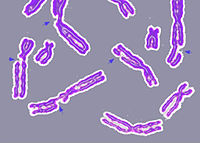
Photo from wikipedia
Cells are constantly exposed to endogenous and exogenous chemical and physical agents that damage their genome by forming DNA lesions. These lesions interfere with the normal functions of DNA such… Click to show full abstract
Cells are constantly exposed to endogenous and exogenous chemical and physical agents that damage their genome by forming DNA lesions. These lesions interfere with the normal functions of DNA such as transcription and replication, and need to be either repaired or tolerated. DNA lesions are accurately removed via various repair pathways. In contrast, tolerance mechanisms do not remove lesions but only allow replication to proceed despite the presence of unrepaired lesions. Cells possess two major tolerance strategies, namely translesion synthesis (TLS), which is an error-prone strategy and an accurate strategy based on homologous recombination (homology-dependent gap repair [HDGR]). Thus, the mutation frequency reflects the relative extent to which the two tolerance pathways operate in vivo. In the present paper, we review the present understanding of the mechanisms of TLS and HDGR and propose a novel and comprehensive view of the way both strategies interact and are regulated in vivo.
Journal Title: Toxicological Research
Year Published: 2018
Link to full text (if available)
Share on Social Media: Sign Up to like & get
recommendations!